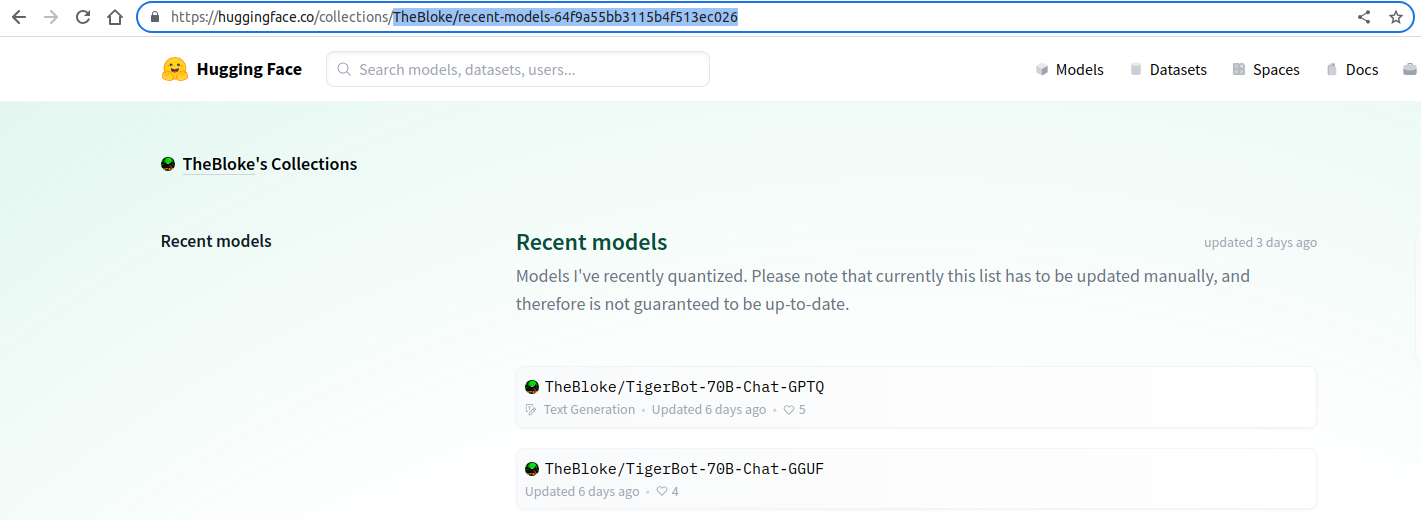Hub Python Library documentation
Collections
Collections
Collection은 Hub(모델, 데이터셋, Spaces, 논문)에 있는 관련 항목들의 그룹으로, 같은 페이지에 함께 구성되어 있습니다. Collections는 자신만의 포트폴리오를 만들거나, 카테고리별로 콘텐츠를 북마크 하거나, 공유하고 싶은 item들의 큐레이팅 된 목록을 제시하는 데 유용합니다. 여기 가이드를 확인하여 Collections가 무엇이고 Hub에서 어떻게 보이는지 자세히 알아보세요.
브라우저에서 직접 Collections를 관리할 수 있지만, 이 가이드에서는 프로그래밍 방식으로 Collection을 관리하는 방법에 초점을 맞추겠습니다.
Collection 가져오기
get_collection()을 사용하여 자신의 Collections나 공개된 Collection을 가져올 수 있습니다. Collection을 가져오려면 Collection의 slug가 필요합니다. Slug는 제목과 고유한 ID를 기반으로 한 Collection의 식별자입니다. Collection 페이지의 URL에서 slug를 찾을 수 있습니다.

"TheBloke/recent-models-64f9a55bb3115b4f513ec026" Collection을 가져와 봅시다:
>>> from huggingface_hub import get_collection
>>> collection = get_collection("TheBloke/recent-models-64f9a55bb3115b4f513ec026")
>>> collection
Collection(
slug='TheBloke/recent-models-64f9a55bb3115b4f513ec026',
title='Recent models',
owner='TheBloke',
items=[...],
last_updated=datetime.datetime(2023, 10, 2, 22, 56, 48, 632000, tzinfo=datetime.timezone.utc),
position=1,
private=False,
theme='green',
upvotes=90,
description="Models I've recently quantized. Please note that currently this list has to be updated manually, and therefore is not guaranteed to be up-to-date."
)
>>> collection.items[0]
CollectionItem(
item_object_id='651446103cd773a050bf64c2',
item_id='TheBloke/U-Amethyst-20B-AWQ',
item_type='model',
position=88,
note=None
)get_collection()에 의해 반환된 Collection 객체에는 다음이 포함되어 있습니다:
- 높은 수준의 메타데이터:
slug,owner,title,description등 - CollectionItem 객체의 목록; 각 항목은 모델, 데이터셋, Space 또는 논문을 나타냅니다.
모든 Collection 항목에는 다음이 보장됩니다:
- 고유한
item_object_id: 데이터베이스에서 Collection 항목의 id - 기본 항목(모델, 데이터셋, Space, 논문)의 Hub에서의
item_id; 고유하지 않으며,item_id/item_type쌍만 고유합니다. item_type: 모델, 데이터셋, Space, 논문- Collection에서 항목의
position으로, 이를 업데이트하여 Collection을 재구성할 수 있습니다(아래의 update_collection_item() 참조)
각 항목에는 추가 정보(코멘트, 블로그 포스트 링크 등)를 위한 note도 첨부될 수 있습니다. 항목에 note가 없으면 해당 속성값은 None이 됩니다.
이러한 기본 속성 외에도, 반환된 항목은 유형에 따라 추가 속성(author, private, lastModified, gated, title, likes, upvotes 등)을 가질 수 있습니다. 그러나 이러한 속성이 반환된다는 보장은 없습니다.
Collections 나열하기
list_collections()를 사용하여 Collections를 나열할 수도 있습니다. Collections는 몇 가지 매개변수를 사용하여 필터링할 수 있습니다. 사용자 teknium의 모든 Collections를 나열해 봅시다.
>>> from huggingface_hub import list_collections
>>> collections = list_collections(owner="teknium")이렇게 하면 Collection 객체의 반복 가능한 객체가 반환됩니다. 예를 들어 각 Collection의 upvotes 수를 출력하기 위해 반복할 수 있습니다.
>>> for collection in collections:
... print("Number of upvotes:", collection.upvotes)
Number of upvotes: 1
Number of upvotes: 5Collections를 나열할 때, 각 Collection의 항목 목록은 최대 4개 항목으로 잘립니다. Collection의 모든 항목을 가져오려면 get_collection()을 사용해야 합니다.
고급 필터링을 수행할 수 있습니다. 예를 들어 모델 TheBloke/OpenHermes-2.5-Mistral-7B-GGUF를 포함하는 트렌딩 순으로 정렬된 Collections를 5개까지만 가져올 수 있습니다.
>>> collections = list_collections(item="models/TheBloke/OpenHermes-2.5-Mistral-7B-GGUF", sort="trending", limit=5):
>>> for collection in collections:
... print(collection.slug)
teknium/quantized-models-6544690bb978e0b0f7328748
AmeerH/function-calling-65560a2565d7a6ef568527af
PostArchitekt/7bz-65479bb8c194936469697d8c
gnomealone/need-to-test-652007226c6ce4cdacf9c233
Crataco/favorite-7b-models-651944072b4fffcb41f8b568sort 매개변수는 "last_modified", "trending" 또는 "upvotes" 중 하나여야 합니다. item 매개변수는 특정 항목을 받습니다. 예를 들면 다음과 같습니다:
"models/teknium/OpenHermes-2.5-Mistral-7B""spaces/julien-c/open-gpt-rhyming-robot""datasets/squad""papers/2311.12983"
자세한 내용은 list_collections() 참조를 확인하시기 바랍니다.
새 Collection 만들기
이제 Collection을 가져오는 방법을 알았으니 우리만의 Collection을 만들어봅시다! 제목과 설명을 사용하여 create_collection()을 호출합니다. 조직 페이지에 Collection을 만들려면 Collection 생성 시 namespace="my-cool-org"를 전달합니다. 마지막으로 private=True를 전달하여 비공개 Collection을 만들 수도 있습니다.
>>> from huggingface_hub import create_collection
>>> collection = create_collection(
... title="ICCV 2023",
... description="Portfolio of models, papers and demos I presented at ICCV 2023",
... )이렇게 하면 (제목, 설명, 소유자 등의) 높은 수준의 메타데이터와 빈 항목 목록을 가진 Collection 객체가 반환됩니다. 이제 slug를 사용하여 이 Collection을 참조할 수 있습니다.
>>> collection.slug
'owner/iccv-2023-15e23b46cb98efca45'
>>> collection.title
"ICCV 2023"
>>> collection.owner
"username"
>>> collection.url
'https://huggingface.co/collections/owner/iccv-2023-15e23b46cb98efca45'Collection의 item 관리
이제 Collection을 가지고 있으므로, 여기에 item을 추가하고 구성해봅시다.
item 추가
item은 add_collection_item()을 사용하여 하나씩 추가해야 합니다. collection_slug, item_id, item_type만 알면 됩니다. 또한 선택적으로 항목에 note를 추가할 수도 있습니다(최대 500자).
>>> from huggingface_hub import create_collection, add_collection_item
>>> collection = create_collection(title="OS Week Highlights - Sept 18 - 24", namespace="osanseviero")
>>> collection.slug
"osanseviero/os-week-highlights-sept-18-24-650bfed7f795a59f491afb80"
>>> add_collection_item(collection.slug, item_id="coqui/xtts", item_type="space")
>>> add_collection_item(
... collection.slug,
... item_id="warp-ai/wuerstchen",
... item_type="model",
... note="Würstchen is a new fast and efficient high resolution text-to-image architecture and model"
... )
>>> add_collection_item(collection.slug, item_id="lmsys/lmsys-chat-1m", item_type="dataset")
>>> add_collection_item(collection.slug, item_id="warp-ai/wuerstchen", item_type="space") # 동일한 item_id, 다른 item_typeCollection에 item이 이미 존재하는 경우(동일한 item_id/item_type 쌍), HTTP 409 오류가 발생합니다. exists_ok=True를 설정하면 이 오류를 무시할 수 있습니다.
기존 item에 메모 추가
update_collection_item()을 사용하여 기존 item을 수정하여 메모를 추가하거나 변경할 수 있습니다. 위의 예시를 다시 사용해 봅시다:
>>> from huggingface_hub import get_collection, update_collection_item
# 새로 추가된 item과 함께 Collection 가져오기
>>> collection_slug = "osanseviero/os-week-highlights-sept-18-24-650bfed7f795a59f491afb80"
>>> collection = get_collection(collection_slug)
# `lmsys-chat-1m` 데이터셋에 메모 추가
>>> update_collection_item(
... collection_slug=collection_slug,
... item_object_id=collection.items[2].item_object_id,
... note="This dataset contains one million real-world conversations with 25 state-of-the-art LLMs.",
... )item 재정렬
Collection의 item은 순서가 있습니다. 이 순서는 각 item의 position 속성에 의해 결정됩니다. 기본적으로 item은 Collection의 끝에 추가되는 방식으로 순서가 지정됩니다. update_collection_item()을 사용하여 메모를 추가하는 것과 같은 방식으로 순서를 업데이트할 수 있습니다.
위의 예시를 다시 사용해 봅시다:
>>> from huggingface_hub import get_collection, update_collection_item
# Collection 가져오기
>>> collection_slug = "osanseviero/os-week-highlights-sept-18-24-650bfed7f795a59f491afb80"
>>> collection = get_collection(collection_slug)
# 두 개의 `Wuerstchen` item을 함께 배치하도록 재정렬
>>> update_collection_item(
... collection_slug=collection_slug,
... item_object_id=collection.items[3].item_object_id,
... position=2,
... )item 제거
마지막으로 delete_collection_item()을 사용하여 item을 제거할 수도 있습니다.
>>> from huggingface_hub import get_collection, update_collection_item
# Collection 가져오기
>>> collection_slug = "osanseviero/os-week-highlights-sept-18-24-650bfed7f795a59f491afb80"
>>> collection = get_collection(collection_slug)
# 목록에서 `coqui/xtts` Space 제거
>>> delete_collection_item(collection_slug=collection_slug, item_object_id=collection.items[0].item_object_id)Collection 삭제
delete_collection()을 사용하여 Collection을 삭제할 수 있습니다.
이 작업은 되돌릴 수 없습니다. 삭제된 Collection은 복구할 수 없습니다.
>>> from huggingface_hub import delete_collection
>>> collection = delete_collection("username/useless-collection-64f9a55bb3115b4f513ec026", missing_ok=True)